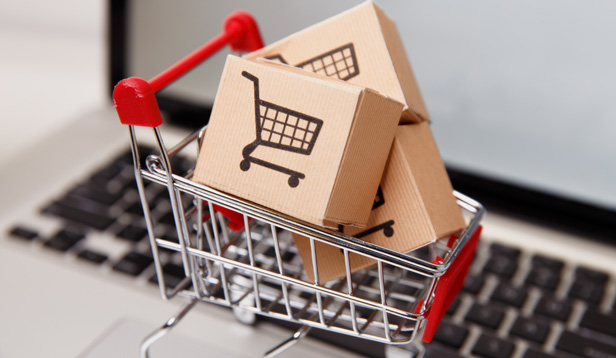News December 22, 2020
In-Store Retail Slows as E-Commerce Gains Momentum
Shopping habits forged during the pandemic will have an impact on the promo products industry.
Brick-and-mortar retail sales fell 1.1% in November during the all-important fourth-quarter shopping season, as the pandemic continues to impact buying trends.
The Commerce Department reported the data about two weeks after Black Friday, normally the country’s busiest shopping day at stores. It’s the first month-to-month drop since April, when the first pandemic shutdowns were implemented, and a more significant contraction than economic analysts had expected.

With new surges in virus cases and the drying up of government aid (though a new package is now on the books and will be in effect through September 2021), consumers slowed down overall spending in November, which bodes ill for retailers and the wider economy.
On Black Friday, half as many shoppers visited stores as last year, according to retail data firm Sensormatic Solutions, after officials warned people to continue sheltering in place. Retailers put their best deals and sales online to encourage e-commerce shopping, though analysts expect another drop in retail traffic between November and December.
In-person retail sales had rebounded this summer after the spring lockdowns, but surges in virus cases – particularly in California, the country’s most populous state – have impacted in-person shopping and dining again. Clothing, electronics and furniture stores were hit hard. Department store sales dropped 7.7% in November, and restaurants saw a 4% drop in business, according to the Commerce Department. Meanwhile, the unemployment rate stood at 6.7% in early December, with about 10 million unemployed people, according to the Bureau of Labor Statistics.
Notably, sales at supermarkets grew by 1.9% and at home improvement stores by 1.1%, while e-commerce revenue was up 0.2%. A new report by media investment company GroupM predicts that digital sales will continue its gradual uptick over the next six years, a testament to permanent changes in buying habits in 2020 as consumers become accustomed to the convenience of online shopping.
Excluding food and delivery services, GroupM estimates that global e-commerce retail sales will total almost $4 trillion by the end of this year, the equivalent of 17% of total global retail sales. By 2024, that number will rise to $7 trillion (25% of global retail), says GroupM, and $10 trillion by 2027.
As a result, brands selling more over e-commerce are now shifting their focuses to digital marketing and ads that drive immediate purchasing, rather than traditional brand awareness.
“It’s a continued migration of talent sets to people who understand data and performance,” Christian Juhl, global chief executive of GroupM, told the Wall Street Journal. “On the supply side, publishers have to quantify the value of their inventory. We’re not settling for broad reach and awareness.”
Already, major brands are leveraging social media to encourage purchasing among Millennials and Gen Z. Last week, Walmart partnered with TikTok for a shoppable livestream called the Holiday Shop-Along Spectacular. TikTok influencers showed off their favorite product picks from Walmart and viewers could instantly purchase the items without leaving the TikTok app.
For the first time ever, we’re bringing you a shopping event on TikTok LIVE! Watch & shop along tonight at 8 PM ET/5 PM PT, as your fave TikTok stars share their top fashion picks. Follow @walmart on TikTok to tune in. #WalmartShopAlong
— Walmart (@Walmart) December 18, 2020
New trends in shopping and commerce are already having an impact on the promotional products industry, which is already adapting to new client demands and expectations. The “Amazon effect” has intensified as suppliers and distributors have hosted fewer or zero in-person visits in recent months as clients opt for video meetings, quick sampling and immediate purchasing options directly from websites.
But the market has some catching up to do. According to Counselor SOI data, the number of suppliers with e-commerce-capable sites was just 30% in 2017, 32% in 2018 and 38% in 2019. Meanwhile, almost half of all distributors had one by the end of 2019.
Those who had e-commerce sites before the pandemic will fare the best moving forward, says Bret Bonnet, president of Top 40 distributor Quality Logo Products. “I don’t think we’ll see the full impact on the industry until maybe 2022, but the acceleration towards e-commerce absolutely took off in 2020,” he says. “Consumer habits have changed permanently, and the established e-commerce players are going to be the ones first in line to benefit the most. The best option now is to buy versus build, but that can be expensive.”
In the not-to-distant future, savvy promo firms may also use e-commerce-enabled video to sell products, like the recent Walmart/TikTok collaboration. “Shoppable video is becoming a top request from some of the biggest brands we work with,” says Oz Etzioni, CEO of Clinch, an AI-powered personalization technology platform. “There’s an old misconception that it’s difficult to execute, which likely stemmed from clunky legacy technology that couldn’t adapt to the evolving media landscape. With today’s agile tech, a scalable execution of shoppable videos can be achieved quickly and with minimal resources.”
Rapidly advancing AI technology makes certain that featured products are a match for the individual viewer, and that inventory and pricing fluctuations are tracked in real time, says Etzioni.
Of course, with increased e-commerce transactions, logistics will have to adjust to keep pace to avoid the widespread and lengthy delivery delays that characterized Q4 of 2020. Bonnet says the logical next step is for freight companies to increase shipping costs and possibly do away with coveted free shipping services in order to restore equilibrium.
“I’m confident all the major carriers will feel emboldened after this holiday season and the pandemic to begin raising prices,” he says. “The current cost structure is just not sustainable, and the one way to reduce the number of shipments is to increase costs.”
